Telescope fish: varieties and care tips
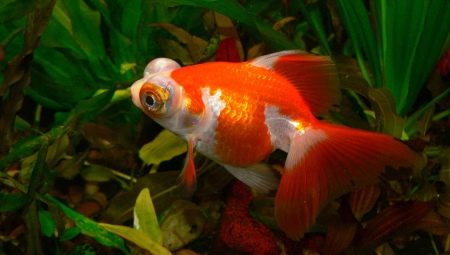
Telescopes are peaceful goggle-eyed fish with a bushy tail. The aquarium with them looks original and eye-catching. In natural conditions, they cannot be found, they live exclusively in captivity. Were bred from goldfish as a result of selection. It is believed that they first appeared in the 16th-17th centuries in China, where they were called dragon's eye or dragon fish. Since then, their appearance has not changed much.

Description
You can recognize the "dragon" by its huge eyes - this is their main difference from goldfish. The shape and direction of the visual organs can be different, but the most common are spherical, cylindrical, and conical eyes. The body of the fish is short, rounded, and the head is quite voluminous. One of the advantages of an aquarium fish is its gorgeous fins and tail, which, when moving, flutter beautifully like a veil.
The lifespan is 15 years, although there are also 20-year-old centenarians. If you create good conditions for the fish, they will live long enough. The size of individuals strongly depends on the volume of the aquarium in which they live. Usually telescopes reach 10 cm in length, but if they are kept in a large tank of 500 liters or more, they can grow up to 20 cm. The color of the calf is different, it can be monochromatic or variegated, depending on the type of telescope.
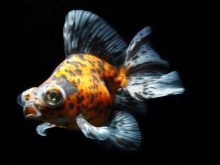
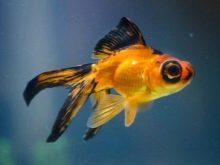

Views
There are a huge number of subspecies of these fish. The criterion for separation is 3 features:
- The size and shape of the fins. There are short-fin, skirt and ribbon breeds.
- Feature of scales, there are two main subspecies: scaly and scaly. The latter have a monochromatic velvety abdomen without a metallic sheen.
- Body color. Telescopes come in a variety of colors, with the most common being black, red and gold.
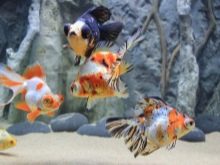
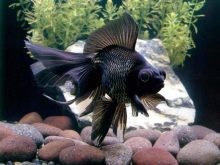
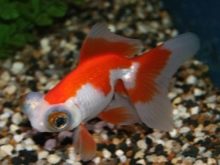
Given these signs, it is possible to determine the "breed" of the pop-eyed fish. The easiest way to do this is by its color. The following types of telescopes can be found in aquariums:
- black moor - this is a telescope of a rich charcoal color, with neat fins and a small tail, it can change color over time;
- panda - differs in black and white symmetrical spots and a velvety scaly body;
- orange telescope - has a monochromatic color of varying intensity;
- calico - in these individuals, many multi-colored spots of different sizes are scattered on a white-silvery body;
- red chinese the telescope has a bright scarlet color;
- magpie - a fish with black fins and a white body;
- brindle - the color of the telescope is similar to the striped skin of a tiger;
- veil-tailed - has beautiful elongated fins and a bushy tail.
Some aquarists distinguish a lion-headed species - the fish have unusual growths on their heads. But since the eyes of individuals are small, they should still be classified as a species of goldfish.
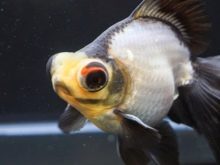
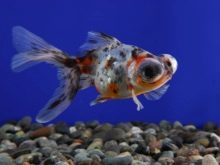
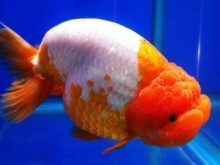
How to determine gender?
In "dragons" it is impossible to determine the sex, males and females look the same and do not differ at all either in fins or in size. Only during the spawning period do distinctive features appear: in males, white, lumpy specks form on the head and in the gills, and in females, the body becomes rounder.
Telescopes are best purchased in flocks, this increases the likelihood of finding males and females in the same aquarium. After spawning, you can try to remember the sex of the fish, focusing on the individual characteristics of the appearance.
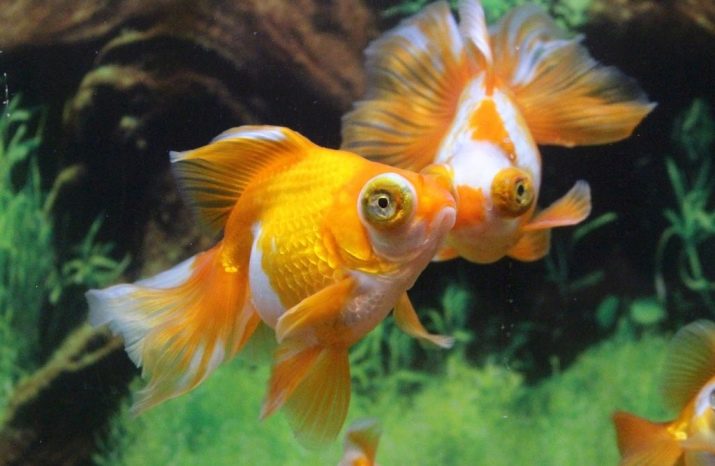
Content rules
When properly maintained, telescopes will delight the aquarist with their bright colors and large size. Although fish are considered unpretentious, nevertheless, the basic rules of content should not be neglected:
- choose and prepare an aquarium correctly;
- water temperature - 22-27 degrees, if necessary, you can use a heater;
- installation of a filtration and aeration system is required;
- acidity (pH) - 6.0–8.0;
- hardness (dH) - 8-25 °;
- follow the rules of feeding.

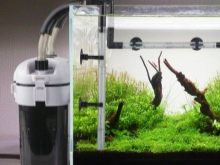

Fish love clean water, so you need to monitor its transparency and change it weekly. In order not to disturb the ecosystem habitual for fish, only 25% of the liquid is drained.
This is done with a bucket or hose. You only need to pour into the aquarium water settled for 3 days. There are many harmful chemical compounds in water pipes, which settle to the bottom during settling. Besides, the water temperature becomes room temperature and corresponds to the aquarium climate... This reduces the likelihood of stress in fish.
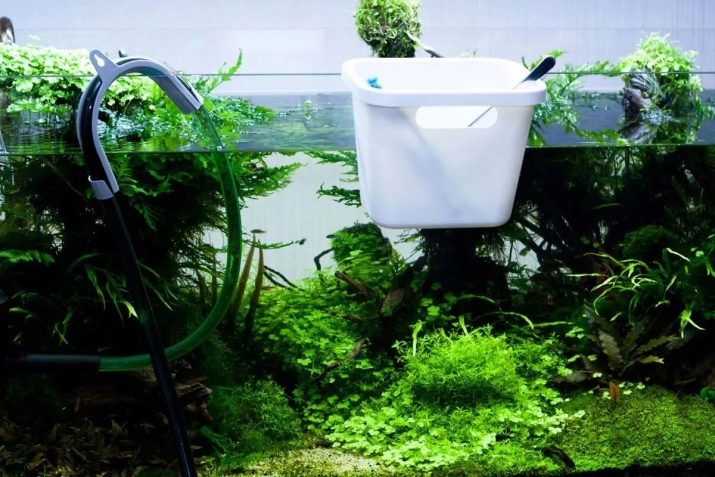
Aquarium equipment
The huge eyes of telescopes see almost nothing, besides this, the fish have a very delicate abdomen - you need to equip the aquarium with these features in mind. It is forbidden to decorate the tank with grottoes, snags and decorative items with pointed ends. The bottom is covered with small smooth pebbles; all sharp pebbles and shells must be removed. This point in the maintenance of telescopes is very important, since the fish are delicate and can get hurt, and sometimes even be left without an eye.
The best decorations for a telescope aquarium are plants. They are planted along the back wall of the tank, leaving more space for comfortable movement of fish.
Thin-leaved, delicate vegetation is not suitable for decoration, as telescopes like to "nibble the grass" and scatter the remains throughout the aquarium, from which the water becomes clogged.
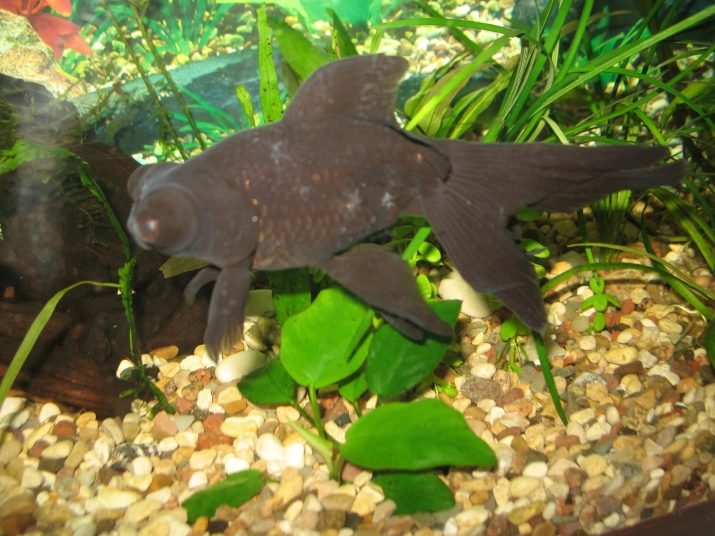
Choose algae with wide, dense leaves and a powerful, well-developed root system:
- sagittaria;
- hygrophilus;
- aponogeton;
- egg capsule;
- bolbitis;
- elodea.

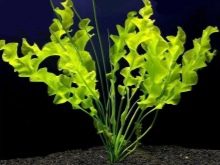
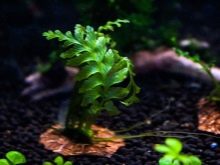
The aquarium for keeping fish should be spacious - at least 80 liters, and even better - about 300 liters, because the growth of fish depends on the size of the tank. They will be comfortable in a wide, low aquarium.
Telescopes like to dig in the ground and eat a lot, from which the water quickly becomes cloudy. Therefore, it is recommended to install good cleaning filters and plant some snails that will remove plaque from the plants and the walls of the aquarium.
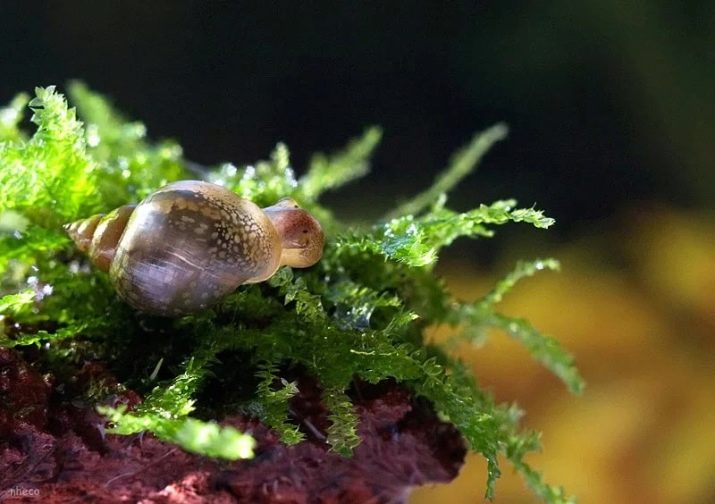
What to feed?
Telescopes love to eat well, they can eat too much food, which is harmful to their health. They do not have a sense of satiety, so it is necessary to give food in small portions, twice a day: in the morning and in the evening. The main diet consists of artificial pellets, which can be purchased at the pet store. Due to their weak eyesight, it is difficult for fish to find particles of food, especially if it is a donkey at the bottom.
Artificial pellets are lightweight, they do not burrow in the soil, so it is easier for fish to find them.
The can of food should be stored in an airtight container, away from sunlight.

Fish require high-quality protein and variety in their diet, so they should be pampered with natural food a couple of times a month. Most suitable:
- daphnia - small crustacean, contains many useful vitamins and minerals;
- brine shrimp - a type of crustaceans, which are eaten with pleasure by all types of fish;
- bloodworm - nutritious high-protein feed;
- core - mosquito larva, which is well absorbed in the fish organism.

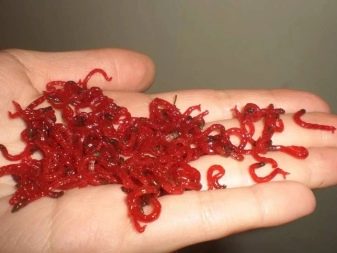
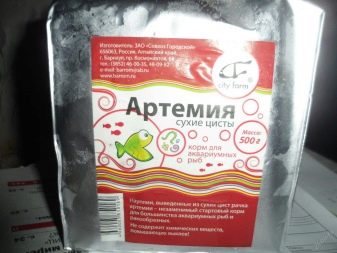

Telescopes love plant foods. Lettuce, cabbage or nettle leaves are scalded with boiling water and placed in an aquarium. "Dragons" will be happy to chew fresh herbs.
Aquarists sometimes recommend doing fasting days for fish: exclude any food for a whole day. This is a good prevention of obesity, which telescopes are so prone to.
Possible problems
Delicate telescopes can get sick. We list the most common ailments that affect these fish.
- Inflammation of the swim bladder. The fish cannot take a stable position in the water: it floats up with its left side or belly up, the abdomen swells, the spine is bent. It is treated with a 3-day fast and raising the temperature in the aquarium to 28 degrees.
- Obesity. Accompanied by passivity and apathy, the abdomen protrudes unnaturally. It is treated with a hunger strike and subsequent dietary meals.
- Bacterial infections and fungus. White plaque or mucus appears on the body, the fish can itch on stones, and in advanced cases it almost always lies at the bottom. In this case, the water in the aquarium is completely changed and antibacterial drugs are used.
- Carp pox - a dangerous viral disease. White-pink formations appear on the body, head and fins. There is no cure for this ailment.
- Oxygen starvation, in which the fish often rises to the surface of the water to swallow air. In this case, aeration is increased and the aquarium is thoroughly cleaned of food debris and rotten plants. In some cases, the temperature of the water is lowered.
- Infection with parasites. Telescopes refuse to eat, become lethargic, and dark spots appear on the body. For treatment, antiparasitic agents are used.
- Cold. The abdomen acquires an earthy color, scales may flake off. For treatment, the water temperature is raised to 26-27 degrees, if necessary, you can use a special heater.
Telescopes are difficult to heal, and it is not always possible to save the fish. Many diseases are caused not only by poor care, but also by feeding the fish with contaminated food. Therefore, aquarists are advised to freeze live food before feeding it to fish.

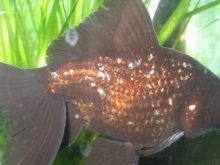
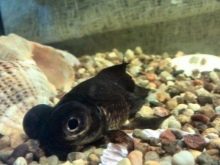
Breeding
Telescopes become sexually mature by the age of two. As noted above, females ready to mate become noticeably rounded, while males develop white spots on their gills. 1 female and several males are transplanted into the spawning grounds.Mating games usually begin in the morning. The female lays eggs, and the males fertilize it. Up to 2,000 eggs can be laid at a time, but not all of them are viable. Dead caviar turns white and covered with plaque.
In order for the fish to start spawning, special conditions are created for them:
- spawning box volume - not less than 30 liters;
- the water level should be low, so choose a wide aquarium;
- water temperature - within 24-27 degrees;
- the aquarium is equipped with good aeration;
- you need to take care of sufficiently bright lighting;
- it is advisable to cover the bottom of the spawning box with Javanese moss;
- to protect the eggs from being eaten, a plastic net is used; it is installed 2 cm above the bottom.


Immediately after spawning, adults are transferred to a common aquarium. The maternal instinct for telescopes is not developed, so they can eat future offspring. But do not rush too much - the male must have time to fertilize the eggs. It is necessary to closely monitor the fish, the entire spawning process usually takes 3 to 5 days.
After 2–5 days, larvae hatch from the eggs, and after a couple of days, fry appear. They start swimming around the aquarium and need food. At this point, they can begin to be fed with live dust (ciliates). The liquid with the food is poured directly into the aquarium using a syringe without a needle. You can gradually include in the diet and dry food, for example, TetraMin Baby. These micro flakes are suitable for feeding babies up to 1 cm in size.
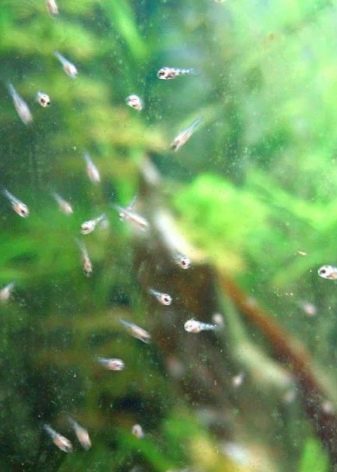
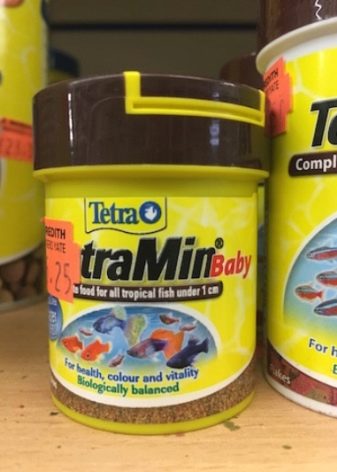
Compatibility with other fish
It is difficult for dragon fish to find neighbors. You cannot keep them together with cichlids, arowans and piranhas - these predators can cause serious damage or even kill. Barbs and some sharks will nibble on their beautiful fins. Neighborhood with nimble fish will also be unsuccessful, they will take food from clumsy and slow telescopes.
But still "dragons" do not like to be alone and get along well with their own kind, so it is recommended to keep them in a flock.
You can also add goldfish, shubunkin or veiled tails, these are peaceful species with similar conditions of detention.
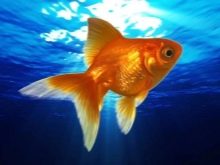
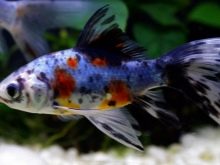
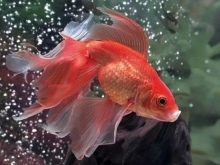
More about the telescope fish is waiting for you in the video below.








